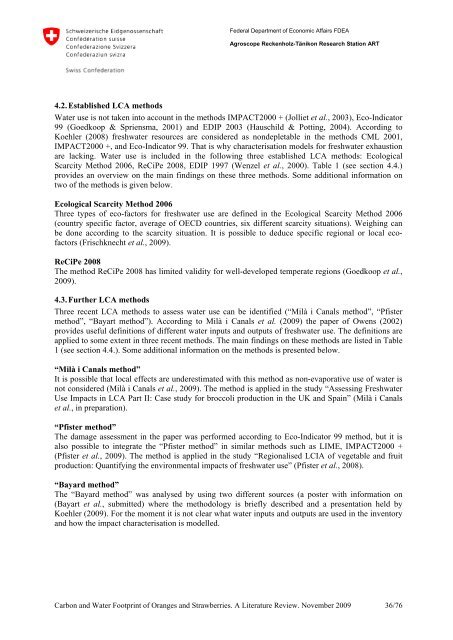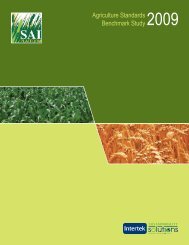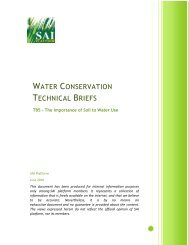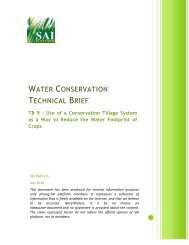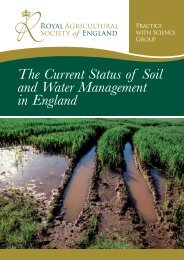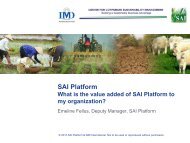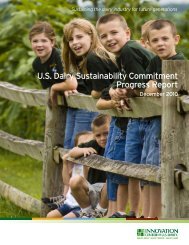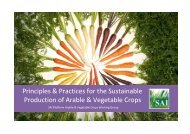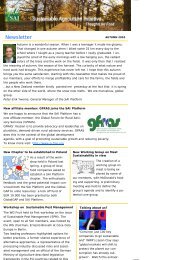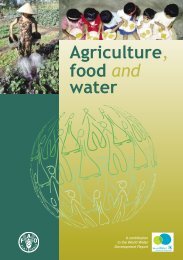Carbon & Water Footprint of Oranges and Strawberries - SAI Platform
Carbon & Water Footprint of Oranges and Strawberries - SAI Platform
Carbon & Water Footprint of Oranges and Strawberries - SAI Platform
You also want an ePaper? Increase the reach of your titles
YUMPU automatically turns print PDFs into web optimized ePapers that Google loves.
Federal Department <strong>of</strong> Economic Affairs FDEA<br />
Agroscope Reckenholz-Tänikon Research Station ART<br />
4.2. Established LCA methods<br />
<strong>Water</strong> use is not taken into account in the methods IMPACT2000 + (Jolliet et al., 2003), Eco-Indicator<br />
99 (Goedkoop & Spriensma, 2001) <strong>and</strong> EDIP 2003 (Hauschild & Potting, 2004). According to<br />
Koehler (2008) freshwater resources are considered as nondepletable in the methods CML 2001,<br />
IMPACT2000 +, <strong>and</strong> Eco-Indicator 99. That is why characterisation models for freshwater exhaustion<br />
are lacking. <strong>Water</strong> use is included in the following three established LCA methods: Ecological<br />
Scarcity Method 2006, ReCiPe 2008, EDIP 1997 (Wenzel et al., 2000). Table 1 (see section 4.4.)<br />
provides an overview on the main findings on these three methods. Some additional information on<br />
two <strong>of</strong> the methods is given below.<br />
Ecological Scarcity Method 2006<br />
Three types <strong>of</strong> eco-factors for freshwater use are defined in the Ecological Scarcity Method 2006<br />
(country specific factor, average <strong>of</strong> OECD countries, six different scarcity situations). Weighing can<br />
be done according to the scarcity situation. It is possible to deduce specific regional or local ec<strong>of</strong>actors<br />
(Frischknecht et al., 2009).<br />
ReCiPe 2008<br />
The method ReCiPe 2008 has limited validity for well-developed temperate regions (Goedkoop et al.,<br />
2009).<br />
4.3. Further LCA methods<br />
Three recent LCA methods to assess water use can be identified (“Milà i Canals method”, “Pfister<br />
method”, “Bayart method”). According to Milà i Canals et al. (2009) the paper <strong>of</strong> Owens (2002)<br />
provides useful definitions <strong>of</strong> different water inputs <strong>and</strong> outputs <strong>of</strong> freshwater use. The definitions are<br />
applied to some extent in three recent methods. The main findings on these methods are listed in Table<br />
1 (see section 4.4.). Some additional information on the methods is presented below.<br />
“Milà i Canals method”<br />
It is possible that local effects are underestimated with this method as non-evaporative use <strong>of</strong> water is<br />
not considered (Milà i Canals et al., 2009). The method is applied in the study “Assessing Freshwater<br />
Use Impacts in LCA Part II: Case study for broccoli production in the UK <strong>and</strong> Spain” (Milà i Canals<br />
et al., in preparation).<br />
“Pfister method”<br />
The damage assessment in the paper was performed according to Eco-Indicator 99 method, but it is<br />
also possible to integrate the “Pfister method” in similar methods such as LIME, IMPACT2000 +<br />
(Pfister et al., 2009). The method is applied in the study “Regionalised LCIA <strong>of</strong> vegetable <strong>and</strong> fruit<br />
production: Quantifying the environmental impacts <strong>of</strong> freshwater use” (Pfister et al., 2008).<br />
“Bayard method”<br />
The “Bayard method” was analysed by using two different sources (a poster with information on<br />
(Bayart et al., submitted) where the methodology is briefly described <strong>and</strong> a presentation held by<br />
Koehler (2009). For the moment it is not clear what water inputs <strong>and</strong> outputs are used in the inventory<br />
<strong>and</strong> how the impact characterisation is modelled.<br />
<strong>Carbon</strong> <strong>and</strong> <strong>Water</strong> <strong>Footprint</strong> <strong>of</strong> <strong>Oranges</strong> <strong>and</strong> <strong>Strawberries</strong>. A Literature Review. November 2009 36/76


